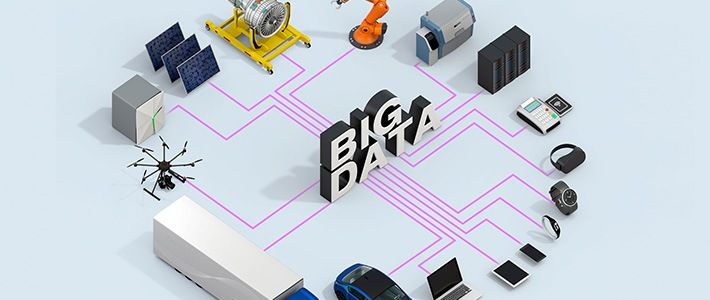
New Era for Big Data as Uses Evolve
Japanese Businesses Must Adapt to Changing Times to Make the Most of Big Data
Economy- English
- 日本語
- 简体字
- 繁體字
- Français
- Español
- العربية
- Русский
The Power of IoT
INTERVIEWER “Data-driven” is a buzzword right now in marketing. What exactly does it mean?
SATŌ Consumers no longer buy products after seeing ads but by reading customer comments or reviews on social media or information sites. Marketers must now analyze the behavior of individual consumer, which generates huge amounts of data. With artificial intelligence and other technologies, though, this “big data” can be evaluated in a blink of an eye.
When people shop online at Amazon, for example, they see messages recommending products other users have bought. Amazon assigns a numerical value based on the interest a customer shows toward products, giving a score of 1 if the user looks at the page for a certain product, 5 if he or she actually buys the product, and 0 if no further action is taken. In this way, even if a person doesn’t make many purchases or only browses a few pages on the site, Amazon can still determine that a customer’s interests are similar to those of other users with comparable numerical patterns and make recommendations accordingly.
Amazon excels at this and usually avoids recommending products that a user isn’t likely to be interested in. This is a good illustration of using AI to process big data on consumer behavior for marketing purposes.
However, other online Japanese marketplaces are not as adept at pushing products as Amazon, either because the pool of comparable users is smaller or they use peripheral data which may not necessarily reflect a user’s consumer habits. If a site recommends a product that a user doesn’t like, chances are he or she will not return. Conversely, a user may feel put off if items being recommended give the impression that a company is tracking their activity too closely. Sites should not recommend popular products exclusively, but neither should they try to move unpopular offerings or overstocked items too aggressively. In this respect, Amazon has developed a very fine-tuned approach.
Point of Sale Changing Business Models
INTERVIEWER What other examples of AI use are there besides product recommendations?
SATŌ The point of sale system that uses bar code readers to scan product information is already wide spread. POS data is sent to computers, where it is used to track things like sales and stock levels.
Twenty years ago, systems could only handle data generated at the time of purchase. But with recent advances in AI and other technologies they can process massive amounts of data much more effectively so that it’s possible to collect point-of-use data on products. Going forward, this type of information will be used much more widely.
For example, in Japan Nissan regularly collects data on the lithium ion batteries inside its all-electric Leaf via charging stations, accumulating it at a data center. By monitoring battery use Nissan can alert drivers to the nearest charging station if necessary. POU technology isn’t used just for cars, though. Once data on product use is collected, it allows stores to regulate inventory and also add new services. Depending on how it’s wielded, it can dramatically change existing business models.
 Satō Ichirō, deputy director general at the National Institute of Informatics
Satō Ichirō, deputy director general at the National Institute of Informatics
IoT Helps Customers Reduce Losses
INTERVIEWER Is this also the case with the Internet of things?
SATŌ IoT and big data go together hand in hand. IoT collects, analyzes, and applies big data. In addition, AI’s machine learning and deep learning capabilities are built on top of big data technology. When big data began emerging about five years ago, data had to be mined from the Internet, but IoT now makes it possible to collect real-world data.
A number of Japanese office equipment makers have networked customers’ printers to monitor things like usage for paper jams, wear on parts, and whether a machine is running low on toner or paper. This means that the company can call customers or send service personnel even before receiving a service request.
For example, if a certain machine is about to run out of toner, the remote management center monitoring the machine can direct the warehouse to send toner. The toner is shipped from the warehouse to a sales office near the customer, from where it can be delivered before the machine runs out of toner completely. In this way, the customer can continue using the machine without ever running out of consumables. Monitoring also helps identify which customers use their machines more at night or on weekends. The office equipment maker can install especially durable equipment on the customer’s premises to prevent sudden breakdowns and minimize interruptions to the customer’s business when service staff is unavailable.
These are examples show how IoT and big data can be effectively combined. A lot of talk about big data focuses on how businesses can use the data analyzed to boost sales or profits, but the examples I give focus on the use of technology to reduce their customers’ losses.
Using Big Data Effectively
INTERVIEWER Is it difficult to boost sales by using big data?
SATŌ It’s very difficult. That’s why most examples of successfully adapting big data focus on cutting customers’ losses. IoT and big data are good at showing what has not worked out for businesses.
For example, an online game operator would analyze former subscribers’ behavior patterns. At the time, users paid a monthly subscription fee, and the operator’s biggest fear was losing subscribers. People generally followed a typical pattern before dropping their subscription where they would access the service less often or interact less with other users. Picking up on these patterns before users lapsed allowed the operator to retain subscribers by providing bonus offers or information about new games.
The characteristics of data that can help businesses make money are less apparent, but those that lead to losses are obvious. This is why it’s better and more effective to apply big data to reducing losses rather than aiming for higher sales over the short term.
Credit card companies provide another example. Firms prevent unauthorized card use by compiling customer spending behavior profiles. Any deviation from a customer’s usual spending pattern sends up a red flag.
Using Big Data on the Front Lines
INTERVIEWER What can be done to identify known data features that up to now have been overlooked?
SATŌ Employees on the front lines are the first to get an idea of what data is of interest to businesses. However, scientists charged with analyzing data often do so without consulting front-line workers. They should do a better job of checking their data against the observations of these people.
Big data analysis begins with a hypothesis that certain data features exist. Data is then collected to verify the hypothesis, and the process is repeated. There might be 100 hypotheses and analysts would be lucky to find the data to support just one of them. It’s impossible to propose a hypothesis without knowing more about actual conditions. This makes it important to collect front-line data and speed up repeating the hypothesis-testing cycle.
There’s also a lot of big data that is overly specific, such as changes in sales after shelf displays in individual stores have been tweaked. This data is more useful to people on the front lines than to company managers. But businesses that don’t give these employees the discretion to make decisions based on this information can’t effectively use big data.
Protecting Personal Data While Also Promoting Its Use
INTERVIEWER What are some concerns about data increasingly being collected on various aspects of our private lives?
SATŌ Data collection could invade privacy and personal information may be leaked. The stronger the technology, the more risks it has, which is something that both developers and users of the technology must be aware of.
As I described in the example about Amazon, big data may create user profiles through inference based on other people’s data. Accurate profiling is convenient, but problems crop up, and even a correct inference can lead to privacy infringement. To protect personal information and privacy, technological safeguards and laws must be put in place that ensure appropriate data use.
Where laws in Japan are concerned, the revised Act on the Protection of Personal Information that in May 2017 takes the use of big data into account. If there are few legal restrictions, then more businesses may use data. However, individuals may then decide they no longer want to provide their data. The law gives consideration to protecting personal information and respecting privacy while also promoting the use and distribution of personal data.
Japan Lags in Data Collection
INTERVIEWER What is the status of big data in Japan right now?
SATŌ IT firms like Amazon, Google, and Facebook all have various ways they collect user date, like electronic commerce, search engines, and ranking features. They then use this proprietary data to expand their businesses and collect even more data.
Japan, on the other hand, is a latecomer in building and using data-collection platforms and continues to lag in this area. The Japanese government’s position is that data is a public good that should be shared. That’s a valid viewpoint, but do data-collection frontrunners like Google or Facebook share their information? No, they don’t. So unless Japanese companies are allowed to keep at least some of the data they collect for their exclusive use, then they have no incentive to gather it.
Japanese companies have plenty of capable personnel on the front lines but that has negative consequences in that both workers and management tend to rely on hunches and past experience. When conditions are static, relying on past experience is enough, but in times of rapid change like today, companies will be left behind unless they can detect and respond to micro-level changes from reality-based data.
(Originally published in Japanese on November 9, 2017. Interview and text by Kuwahara Rika of Power News. Banner photo: © chesky/Pixta.)